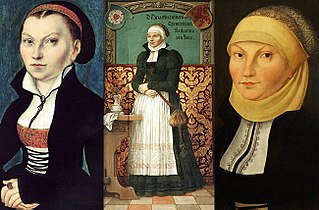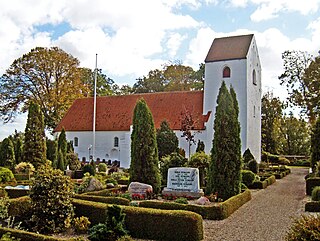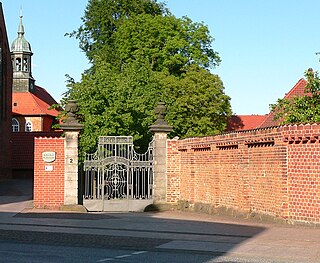
Ebstorf Abbey (German : Abtei Ebstorf or German : Kloster Ebstorf) is a Lutheran convent of nuns that is located near the Lower Saxon town of Uelzen, in Germany. [1]

Ebstorf Abbey (German : Abtei Ebstorf or German : Kloster Ebstorf) is a Lutheran convent of nuns that is located near the Lower Saxon town of Uelzen, in Germany. [1]
The abbey was founded around 1160 as the Priory of Saint Maurice for the Premonstratensian Canons Regular by Volrad von Bodwede, Count of Dannenberg, and a nephew of Henry the Lion. By founding the priory, Volrad hoped to consolidate his influence over the region. It is mentioned in the records for the first time in 1197. It belongs to the six so-called Lüneklöstern (monasteries of Lüne) which became Lutheran convents following the Protestant Reformation.
After a fire in the 13th century the house was given to the Benedictine nuns of Walsrode Abbey who established a daughter house there, and Ebstorf became a place of Marian pilgrimage (Marienwallfahrtsort). The abbey buildings, dating from the 14th century and built in a North German Brick Gothic style, are fully preserved today, as is the church, which still has the raised nun's gallery. The Propstei (provostry) dates to the 15th century.
In the 15th century the life of the nuns changed, as a result of their being placed under the reforming program of the newly established Bursfelde Congregation, that demanded a stricter way of life.
In 1529 the Duke of Welf, Ernest the Confessor from Celle converted the monastery to a Lutheran convent, but the transformation of the monastery was not completed until 1565. It is currently one of several Lutheran convents that are maintained by the Monastic Chamber of Hanover (German : Klosterkammer Hannover ), an institution of the former Kingdom of Hanover founded by its Prince-Regent, later King George IV of the United Kingdom, in 1818, in order to manage and preserve the estates of Lutheran convents on their behalf. It is now maintained as an institution of Hanover's successor state of Lower Saxony. Lutheran women still live there today under the authority of a Lutheran abbess.
The abbey is famous for the Ebstorf Map, a mappa mundi from the 13th century. The original was burned during a bombing raid in 1943 on Hanover. However a faithful copy of the original can be seen in the monastery.
Other points of interest are the medieval stained glass windows in the Nonnenchor (nun's choir), the statues of the Virgin Mary in the cloisters which date from the 13th to 15th centuries, a figure of Saint Maurice, the patron saint of the house, a baptismal font dating from 1310 and a pulpit built in 1615. In addition there a various medieval chests and cupboards.
A religious order is a subgroup within a larger confessional community with a distinctive high-religiosity lifestyle and clear membership. Religious orders often trace their lineage from revered teachers, venerate their founders, and have a document describing their lifestyle called a rule of life. Such orders exist in many of the world's religions.

Ettal Abbey is a Benedictine monastery in the village of Ettal close to Oberammergau and Garmisch-Partenkirchen in Bavaria, Germany. With a community of more than 50 monks, with another five at Wechselburg, the Abbey is one of the largest Benedictine houses and is a major attraction for visitors.

Maulbronn Monastery is a former Cistercian abbey and ecclesiastical state in the Holy Roman Empire located at Maulbronn, Baden-Württemberg. The monastery complex, one of the best-preserved in Europe, was named a UNESCO World Heritage Site in 1993.

Huysburg is a Benedictine monastery situated on the Huy hill range near Halberstadt, in the German state of Saxony-Anhalt. The Romanesque abbey has existed since about 1080 and was secularised in 1804. A new Benedictine community was founded in 1972 and has been headed by a prior since 1984.

The Comburg is a former Benedictine monastery near Schwäbisch Hall, Germany.

The status of Women in the Protestant Reformation was deeply influenced by Bible study, as the Reformation promoted literacy and Bible study in order to study God's will in what a society should look like. This influenced women's lives in both positive and negative ways, depending on what scripture and passages of the Bible were studied and promoted. The ideal of Bible study for commoners improved women's literacy and education, and many women became known for their interest and involvement in public debate during the Reformation. In parallel, however, their voices were often suppressed because of the edict of the Bible that women were to be silent. The abolition of the female convents resulted in the role of wife and mother becoming the only remaining ideal for a woman.

The Abbey Pax Mariae, more commonly referred to as Vadstena Abbey, is situated on Lake Vättern in the Roman Catholic Diocese of Stockholm and is a monastery of nuns within the Bridgettine Order. It was active from 1346 until 1595 and has been active since 1963, regaining status as an autonomous abbey in 1991.

Wienhausen Abbey or Convent near Celle in Lower Saxony, Germany, is a community of Evangelical Lutheran women, which until the Reformation was a Cistercian Catholic nunnery. The abbey owns significant artworks and artifacts, including a collection of tapestries and the earliest surviving example of a type of eyeglasses.

Sebber Priory was a religious house located at Sebbersund, near Nibe in northcentral Jutland, Denmark. The site is now occupied by Sebber Church as well as Sebber Kloster Golf Club and Sebber Abbey manor house.

Ringsted Abbey was one of the earliest and most influential Benedictine houses in Denmark, active from the late 11th-century until the Danish Reformation. It was located at Ringsted on the Danish island of Zealand.

Walsrode Abbey in Walsrode, Germany, is one of the historic monasteries of Benedictine nuns on the Lüneburg Heath in North Germany which are collectively known as the Lüneklöster. Today it is a Lutheran women's convent that is maintained by the Hanover monastic chamber.

Lüne Monastery is a former Benedictine nunnery in the Lower Saxon town of Lüneburg. Today it is a Protestant Lutheran convent and is managed by the Klosterkammer Hannover. The current abbess is Reinhild Freifrau von der Goltz.

Medingen Abbey or Medingen Convent is a former Cistercian nunnery. Today it is a residence for women of the Protestant Lutheran faith near the Lower Saxon town of Bad Bevensen and is supervised by the Monastic Chamber of Hanover. The current director of the abbey (Äbtissin) is the art historian Dr Kristin Püttmann.

The Abbey of the Holy Cross in Rostock, Germany, was founded in the 13th century by Cistercian nuns. It is the only fully preserved abbey in the city. The complex includes the former abbey church which is used today as the University Church (Universitätskirche). The remaining former convent buildings house the Museum of Cultural History for the city of Rostock.

Rüegsau Priory was a 12th-century Swiss monastery of Benedictine nuns in Rüegsau, in the Canton of Bern. It was dissolved in 1528 as a result of the Reformation in Switzerland.
About an hour drive to south from Hamburg, there is a Lutheran Nunnery (ger. Kloster Ebstorf). It has functioned without interruption to this day even after the Reformation.